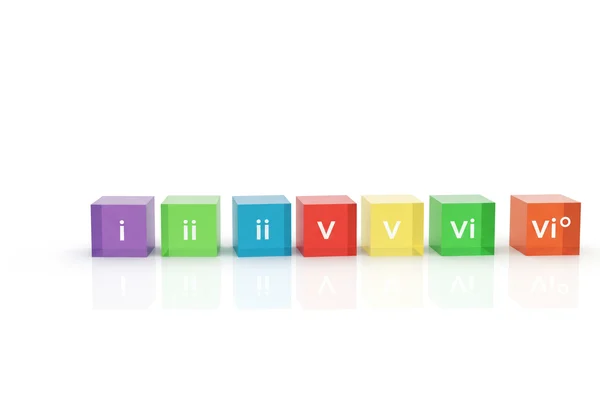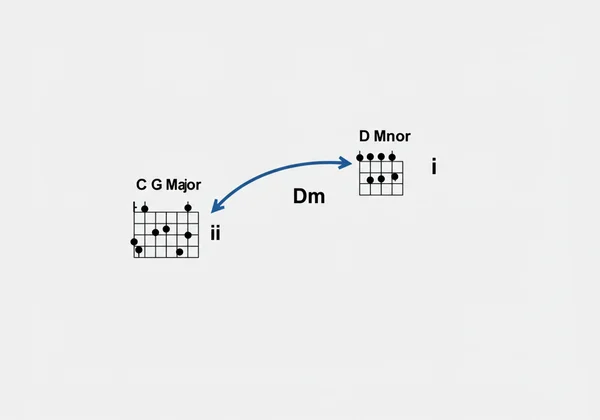ii-V-I Progression: A Circle of Fifths Guide
Have you ever listened to a song and wondered how the chords flow so seamlessly, creating a sound that feels both professional and emotionally satisfying? As a songwriter or musician, you might have struggled with chord progressions that sound random, disjointed, or stiff. If you're looking for the "secret sauce" behind countless pop, R&B, and jazz hits, you've found it. Today, we're unlocking the power of the ii-V-I progression, the most important sequence in Western music theory. And we’ll show you a foolproof, visual way to master it using the Circle of Fifths.
The best part? You don't need to memorize complex formulas or spend hours buried in textbooks. With an intuitive and visual approach, you can start writing more compelling music today. Let's dive in and transform your understanding of harmony with our interactive Circle of Fifths.
What Makes Chord Progressions Sound Good?
Before we can build a house, we need to understand the bricks. In music, those bricks are chords, and the way we arrange them is what creates a chord progression. Not all arrangements are equal; some, like the ii-V-I, have a magnetic pull that our ears naturally love. This is due to a core principle of music: tension and release.
Good common chord progressions create a journey for the listener. They build anticipation (tension) and then provide a satisfying conclusion (release). The ii-V-I progression is the undisputed champion of this concept, creating a powerful sense of resolution that feels like coming home.
Understanding Diatonic Chords as Your Building Blocks
To grasp the ii-V-I, we first need to know about diatonic chords. Simply put, these are the chords that naturally belong to a specific key. Every major key has a family of seven chords built from its scale. We label these chords with Roman numerals to understand their function: I, ii, iii, IV, V, vi, and vii°.
Notice the capitalization: major chords get uppercase numerals (I, IV, V), and minor chords get lowercase (ii, iii, vi). The 'I' chord, also called the tonic, is the "home base" of the key. For example, in the key of C Major, the diatonic chords are:
- I: C Major
- ii: D minor
- iii: E minor
- IV: F Major
- V: G Major
- vi: A minor
- vii°: B diminished
Think of these as your palette of colors for a specific key. The ii-V-I simply picks three of these colors—the second, the fifth, and the first—to create a masterpiece of sound.

The Power of Tension and Release in Music
So, why this specific order? It's all about creating that satisfying tension and release. The V chord (the dominant) has the strongest pull back to the I chord (the tonic). It creates a feeling of suspense, like the moment before a movie's hero saves the day. Your ear is desperate to hear it resolve.
The ii chord (the subdominant) acts as a perfect setup for the V chord. It creates a gentle push that leads smoothly into the V chord's powerful tension. This creates a chain reaction: the ii prepares the V, and the V resolves to the I. This movement is what makes the ii-V-I progression sound so final, so strong, and so "right."
Finding ii-V-I Chords with the Circle of Fifths
Memorizing the ii-V-I progression in all twelve keys can feel like a monumental task. This is where the Circle of Fifths transforms from a confusing chart into your ultimate cheat sheet. It provides a visual map of all the keys, allowing you to find circle of fifths chords and progressions instantly, without any guesswork.
Instead of relying on abstract theory, you can see the relationships right in front of you. This is the fastest way to internalize how harmony works and apply it directly to your instrument or songwriting.
A Visual Guide to Finding the ii-V-I in Any Major Key
Ready for the easiest music theory trick you'll ever learn? Finding a ii-V-I progression on the Circle of Fifths is incredibly simple. Just follow this pattern:
- Pick your "I" (Tonic): Choose any major key on the outer ring of the circle. This is your destination, your "home" chord. Let's pick C Major.
- Find your "V" (Dominant): Move one step clockwise. That's your V chord. For C Major, one step clockwise is G Major.
- Find your "ii" (Subdominant): Move one more step clockwise from the V chord. That's your ii chord. For G Major, one step clockwise is D. Since it's the 'ii' chord, we make it minor: D minor.
There you have it: the ii-V-I progression in C Major is Dm - G - C. It’s that simple. This clockwise movement works for every single key.

Don't justtake our word for it. See for yourself! Open our interactive Circle of Fifths, click on the key of C, and watch as our tool instantly highlights the related diatonic chords, including the ii (Dm), the V (G), and the I (C). You can even click on them to hear the progression.
How to Find the Minor Key ii-V-i
The ii-V-I isn't just for major keys. It's equally powerful in minor keys, creating a darker, more dramatic sound. Finding minor key progressions on the Circle of Fifths is just as easy. The inner ring of the circle shows the relative minor for every major key.
To find the minor ii-V-i, the pattern is slightly different but follows the same logic. Let's find it for A minor (the relative minor of C Major):
- Pick your "i" (Tonic): Select A minor on the inner ring.
- Find your "V" (Dominant): The V chord is E Major. In minor keys, the V chord is almost always made major to create a stronger pull back to the tonic.
- Find your "ii" (Subdominant): The ii chord in a minor key is a diminished chord. In the key of A minor, this is B diminished (B°).
So, the minor ii-V-i in A minor is B° - E - Am. You can explore our tool to see these minor key relationships and hear how they create a different emotional mood.
Real-World Use: The ii-V-I in Music Theory and Pop Hits
This isn't just a dry exercise in music theory basics; the ii-V-I progression is the backbone of the music you listen to every day. From chart-topping pop songs to complex jazz standards, this progression is everywhere once you know how to listen for it. Recognizing it in the wild is a huge step toward becoming a more proficient musician and songwriter.
The ii-V-I in Pop and R&B (e.g., "Sunday Morning" by Maroon 5)
Pop and R&B producers love the ii-V-I for its smooth, satisfying sound. A perfect example is "Sunday Morning" by Maroon 5. The main progression is Dm7 - G7 - Cmaj7. That's a classic ii-V-I in the key of C Major, just using richer-sounding seventh chords.
This progression gives the song its laid-back, soulful feel. It's sophisticated yet instantly catchy. The next time you're working on a pop song, try dropping in a ii-V-I. You can use our music theory tool to quickly find the right chords for your chosen key and hear how they sound.

The ii-V-I as the Foundation of Jazz (e.g., "Autumn Leaves")
If pop music uses the ii-V-I, then jazz music is built on it. It is the fundamental building block of jazz harmony. Standards like "Autumn Leaves" are essentially a string of ii-V-I progressions moving through different keys. For jazz improvisers, recognizing the ii-V-I is essential for navigating the changes.
Learning to identify and play over this progression is a rite of passage for any aspiring jazz musician. The Circle of Fifths becomes an indispensable map for understanding how these jazz standards modulate from one key to another so effortlessly.
Level Up: Using Seventh Chords for a Richer Sound (iim7-V7-Imaj7)
Once you're comfortable with basic ii-V-I triads, you can "level up" your sound by using seventh chords. Adding the seventh to each chord creates a richer, more complex harmony that is common in jazz, R&B, and sophisticated pop. The progression becomes iim7 - V7 - Imaj7.
In our C Major example, this would be Dm7 - G7 - Cmaj7. This subtle change adds a layer of depth and emotion that can elevate your songwriting from good to great. We encourage you to try it yourself. Go to our interactive tool, select a key, and click to hear the difference between the simple triads and the lush seventh chords.
Start Building Better Progressions Today
The ii-V-I progression is more than just three chords; it's a fundamental principle of musical storytelling. It creates a satisfying arc of tension and release that has captivated listeners for centuries. We've shown you that this powerful tool isn't locked away in dense theory books—it's visually and intuitively accessible through the Circle of Fifths.
Stop feeling stuck with random chords that don't go anywhere. Start writing progressions that sound intentional, professional, and emotionally resonant. The Circle of Fifths is your map, and the ii-V-I is your golden path.
Ready to put theory into practice? Go to our interactive Circle of Fifths tool now, pick a key, and build your first ii-V-I progression in seconds.
Frequently Asked Questions About the Circle of Fifths
How do you use the circle of fifths for chord progressions?
The Circle of Fifths is a visual map of the 12 musical keys. For chord progressions, you use it to see the relationships between chords instantly. For the common ii-V-I progression, for instance, you simply pick your home chord (I), and the V and ii chords are the two chords immediately clockwise from it on the circle. Our interactive circle of fifths chart makes this even easier by highlighting all related chords for any key you select.
What are the main chords in the key of G major?
The seven main (diatonic) chords in the key of G Major are: G Major (I), A minor (ii), B minor (iii), C Major (IV), D Major (V), E minor (vi), and F# diminished (vii°). Instead of memorizing this, you can visit our website and click on 'G' on the interactive circle. The tool will instantly display this entire list for you, and you can even click each one to hear how it sounds.
Why is the ii-V-I progression so common?
The ii-V-I progression is so common because it perfectly executes the musical concept of tension and release. The V chord (dominant) creates the most tension and has the strongest desire to resolve to the I chord (tonic or home). The ii chord serves as a smooth preparation for the V chord, creating a logical and powerful path back home. This journey is incredibly satisfying to the human ear, which is why it has become the foundation of countless songs across nearly every genre.